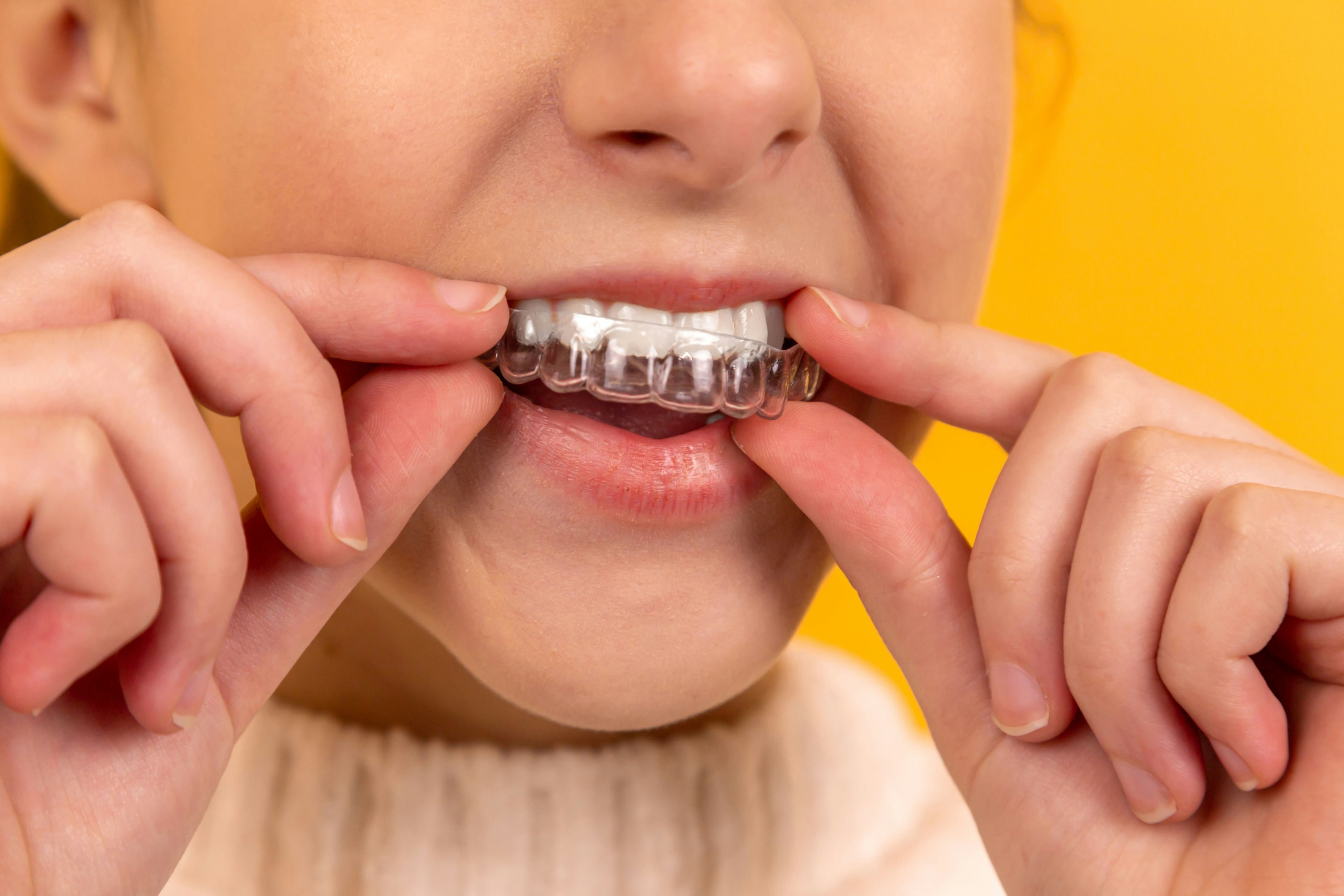
Invisalign vs braces, which one is right for you? This guide will help you decide which is right for your needs.
Key Takeaways
- Invisalign offers a discreet, comfortable, and removable alternative to traditional braces, making it popular for those seeking aesthetic solutions.
- Traditional braces are more effective for individuals with complex orthodontic issues, providing comprehensive correction for severe misalignments.
- Cost and treatment duration differ between Invisalign and braces, with Invisalign generally being more expensive but offering quicker results for minor cases.
Understanding Invisalign

Invisalign treatment involves wearing clear, removable aligners that progressively align teeth without brackets or wires. These aligners are custom-made using 3D imaging technology, ensuring a perfect fit for each patient’s unique dental structure. The Invisalign process starts with a consultation, where a detailed treatment plan is created. This plan outlines the movements of each tooth and predicts the final result.
Invisalign’s appeal lies in its discreet nature. Invisalign aligners are nearly invisible, making them popular with adults and teens. They apply light and constant pressure to gradually shift teeth into position. As patients progress through their treatment, they receive new aligners approximately every one to two weeks. This constant update ensures the teeth continue moving according to the treatment plan.
Invisalign offers several benefits of invisalign over traditional braces. The aligners can be removed, which facilitates good oral hygiene. They also allow for unrestricted eating. Furthermore, the smooth plastic of the aligners reduces the risk of mouth irritation, providing a more comfortable experience than metal braces.
An Invisalign aligner is a compelling option for those seeking a subtle and effective way to straighten teeth with Invisalign treatments.
Traditional Braces Explained

Traditional braces, often called metal braces, are composed of stainless steel brackets and wires that move teeth into alignment. The brackets are bonded to each tooth, and an archwire runs through them, applying continuous pressure to shift the teeth over time. Elastic bands, known as ligatures, help keep the archwire in place, ensuring consistent force on the teeth.
Braces effectively correct many orthodontic issues, from severely crooked teeth to severe bite problems and jaw misalignments. They are particularly suitable for complex cases that require significant tooth movement or adjustments. The process involves regular orthodontist visits, where the archwires are tightened to facilitate ongoing tooth movement.
While traditional braces are more noticeable than clear aligners, they offer unmatched effectiveness for complex dental alignment issues. They can address severe crowding, spacing issues, and even significant jaw misalignments. Traditional braces often provide the best results for patients with severe orthodontic problems.
Cost Comparison: Invisalign vs Braces
Invisalign treatment tends to be somewhat more expensive than traditional braces. The average cost for both Invisalign aligners and conventional braces can vary based on the case’s complexity and the treatment duration. Traditional braces can vary and are influenced by location and the specific dental issues being addressed.
Insurance can help manage orthodontic treatment costs, but not all plans cover Invisalign. It’s important to check with your provider for your coverage options.
Monthly payment plans are available for both Invisalign and traditional braces, making these treatments more affordable. These plans typically last 12 to 36 months, allowing patients to spread out the payments and manage their budgets effectively. When considering the cost, it is essential to weigh the benefits and ensure the chosen treatment aligns with your budget and dental needs.
Aesthetics and Comfort
Aesthetics and comfort are crucial factors when deciding between Invisalign and traditional braces. Invisalign is favoured for its nearly invisible design. Comfort is another significant consideration. Due to its smooth plastic design, Invisalign is often the most comfortable.
Appearance and Visibility
Invisalign aligners are virtually invisible, providing a significant aesthetic advantage over traditional braces. The clear, transparent aligners are designed to be subtle, making them a preferred choice for those who are conscious about their appearance. In professional and social settings, Invisalign doesn’t draw attention to their orthodontic treatment.
On the other hand, traditional metal braces are more visible. While they are effective, their appearance can concern many, especially adults. The visibility of braces can impact one’s confidence, making Invisalign a more attractive option for those seeking a discreet treatment solution.
Comfort Levels
Invisalign aligners are smooth plastic, which reduces the risk of discomfort and mouth irritation. They are also removable, allowing patients to eat and clean their teeth more efficiently, enhancing overall comfort. This design helps avoid common issues associated with braces, such as cuts on the inside cheeks and the need for salt washes.
While both Invisalign and traditional braces can cause some discomfort when moving teeth, traditional metal braces are more likely to cause mouth irritation due to their metal components. The brackets and wires can rub inside of the mouth, leading to sores and discomfort.
Invisalign offers a clear aligner advantage for a more comfortable orthodontic experience.
Treatment Duration
For minor adjustments, Invisalign treatment can be completed in as little as three months, with the average duration being around 12 months. For more complex cases, the treatment duration generally ranges from 12 to 18 months.
Traditional braces, on the other hand, typically require a longer treatment duration, averaging around two years. While braces can handle complex cases more effectively, they usually take longer to achieve the desired results. The correction level needed can significantly affect the treatment time for both Invisalign and braces.
Ultimately, the treatment duration will depend on the specific orthodontic issues being addressed and the patient’s compliance with the treatment plan. Those seeking a faster solution for minor adjustments may find Invisalign more suitable, while traditional braces may be necessary for more complex cases.
Oral Hygiene and Maintenance

Invisalign aligners can be cleaned using various methods, such as crystals or vinegar solutions. They must be rinsed and dried before being put back in the mouth to maintain hygiene. Because the aligners are removable, cleaning your teeth is more straightforward than traditional braces.
To maintain dental hygiene, traditional braces require extra time, careful brushing, and flossing around the brackets and wires. Orthodontic tools like interdental brushes and water flossers are essential for effective cleaning. Failure to clean teeth properly with braces can lead to plaque build-up, staining, decay, and white spot lesions.
Invisalign offers a more convenient solution for those who prioritize ease of maintenance.
Food and Dietary Restrictions
Dietary restrictions are a vital consideration for anyone undergoing orthodontic treatment. Invisalign aligners are removable, allowing patients to eat whatever they like by simply taking them out during meals. Invisalign patients can enjoy hard or chewy foods without worrying about harming their aligners.
In contrast, traditional braces come with several dietary restrictions. Patients should avoid chewy, crunchy, sticky foods that can damage the brackets and wires. Foods like popcorn, nuts, and caramel can be particularly problematic. Instead, braces patients should opt for soft foods like yogurt, pasta, and cooked vegetables.
Invisalign is the more flexible option for those who prefer fewer dietary limitations.
Effectiveness for Complex Cases
Traditional braces often prove more effective in complex orthodontic cases. Braces can handle severe orthodontic conditions, including jaw misalignment, crowding, and significant spacing issues. They are particularly recommended for cases requiring substantial tooth movement and adjustments.
While effective for mild to moderate cases, Invisalign may not be the best choice for complex dental problems. Severe overcrowding and significant gaps may require the more robust approach traditional braces provide. Occasionally, orthodontists recommend supplemental treatments alongside Invisalign to achieve the desired results.
Traditional braces are often preferred for those with complex dental needs.
Frequency of Orthodontist Visits
The frequency of orthodontist visits can differ between Invisalign and traditional braces. Invisalign patients typically receive new aligners every one to two weeks. These pre-fabricated aligners reduce the need for frequent orthodontic visits, as the treatment is designed to progress with fewer check-ups.
Traditional braces require more regular visits to the orthodontist for adjustments and tightening of the archwires. These visits ensure the braces apply the correct pressure for effective tooth movement.
While Invisalign may require fewer visits, patients must still consult their orthodontist if they lose an aligner or don’t see the expected results. Invisalign can be more convenient for those seeking treatment with fewer appointments.
Patient Compliance and Lifestyle
Patient compliance is essential for successful orthodontic treatment with Invisalign aligners, which should be worn for 20 to 22 hours daily. Consistent wear is vital; irregular use can prolong treatment and compromise results. Those with previous orthodontic treatments may exhibit lower compliance with aligners.
Lifestyle adjustments are necessary for both Invisalign and traditional braces. Invisalign offers more flexibility, allowing patients to remove the aligners for eating and special occasions. However, this flexibility requires discipline to ensure the aligners are worn for the recommended time.
Invisalign can be excellent for those who prioritize lifestyle convenience and are willing to commit to wearing the aligners consistently.
Choosing the Right Treatment
Choosing between Invisalign and traditional braces depends on various factors, including individual dental needs, lifestyle, and personal preferences. Consulting an orthodontist is crucial to understanding which treatment suits your orthodontic problem. The decision should align with your treatment goals and lifestyle.
Summary
In summary, both Invisalign and traditional braces effectively lead to a perfect smile. Invisalign is favoured for its discreet look, comfort, and flexibility, while traditional braces excel in treating complex dental issues.
When choosing between the two, consider cost, treatment duration, oral hygiene, and lifestyle. Consulting an orthodontist can help you find the best option. InLine Braces is an excellent Orthodontist who will take wonderful care of you!
Frequently Asked Questions
What is the average cost of Invisalign and traditional braces?
The average cost for Invisalign and traditional braces depends on the complexity of the case and the treatment duration. Discussing your specific needs with an orthodontist for a more precise estimate is essential.
How often do I need to visit the orthodontist with Invisalign compared to braces?
With Invisalign, you’ll visit the orthodontist less often. You typically need appointments every six to eight weeks for new aligners, compared to more frequent visits for adjustments with traditional braces.
Can Invisalign treat complex dental issues?
Invisalign is effective for both mild to moderate dental issues and may not adequately address complex problems, whereas traditional braces are often better.
Are there any dietary restrictions with Invisalign?
Invisalign aligners can allow you to eat without restrictions. This provides greater flexibility than traditional braces, which have more dietary limitations.
How does patient compliance affect orthodontic treatment success?
Patient compliance significantly impacts orthodontic treatment success, as both Invisalign and traditional braces require diligent wear and care. Proper adherence to treatment guidelines ensures optimal results and minimizes complications.
